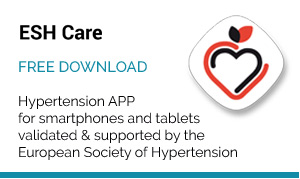June 17, 2007 – Milan, Italy – The very elderly have a 2-fold higher prevalence of 25 common symptoms, according to an analysis of this population in the HYVET study compared to the Syst-Eur population, who were 13 years younger on average. Prof. R. Peters, Imperial College, London, UK, presented this and another analysis of the HYVET data at the 17th European Meeting on Hypertension in Milan, June 15-19, 2007.
The analysis of baseline data in 1,789 elderly over 80 years of age (61% women) in the HYVET study of hypertension treatment in the elderly revealed that nocturia (88%) was the most common symptom reported and rash (9%) the least reported. A significantly higher prevalence of 15 of the 25 symptoms was reported by women than by men. Only two symptoms, nocturia and dry cough, were more significant in men than women.
Assessment of quality of life (QoL) in the elderly must include consideration of the benefit-risk ratio of treatment. Untreated hypertension is associated with reported symptoms of nocturia, headache, unsteadiness compared to the non-hypertensive population, while treated hypertension is associated with reported symptoms of nocturia, swollen ankles, and dry mouth.
The HYVET trial is an international randomized, double-blind, placebo-controlled trial to investigate whether or not to treat moderate hypertension in persons 80 years of age or older. The target blood pressure (BP) is 150/80 mmHg and patients are randomized to treatment with indapamide SR (1.5 mg) and/or perindopril (2-4 mg) or placebo. Additional analyses are looking at quality of life (QoL) and cognition. Patients are recruited from general practice and hospital in both urban and rural settings in Europe, North America, China, and Australasia. More than 3,700 persons have been randomized to date, and the investigators anticipate reporting the final results in mid-2009.
To investigate whether or not self-reported health predicts stroke and acute coronary events, a variety of instruments are being administered in the HYVET study at baseline and annually. These include a self-completed symptom checklist of 25 symptoms, provided in large font and local language, to be completed before any clinic assessments; 82% of HYVET centers have returned this voluntary questionnaire that rates symptoms, and is similar to that used in the Syst-Eur study.
Other instruments are the Short Form-35 used to assess QoL and is established to be suitable for use in the elderly, the Clock Drawing Test to assess global cognitive function, and the Geriatric Depression Scale.
In this analysis of symptoms, women were slightly older, with slightly higher systolic and slightly lower diastolic BP, and were less educated. Details are shown in the Table.
|
A high prevalence of symptoms was reported at baseline on the self-reported symptom checklist, in one-third to one-half of the population in this HYVET analysis. In men, nocturia and erectile dysfunction were the most commonly reported symptoms.
Analysis by sex show that in women, 15 of 25 were more commonly reported, while in men, 2 symptoms were most common (nocturia 92% vs 86% in women, p<0.001; dry cough 39% vs 33% in women, p=0.02). Smoking was shown not to impact dry cough in men.
Compared to the younger population in Syst-Eur (mean age 70 years), only 6 symptoms were significantly different in women and men: headache, blurred vision, swollen ankles, constipation, cramps in legs, and severe pain in joints.
Notably, in the HYVET analysis, report of symptoms increased with age. For each 1 year of increased age in women there was an increase in weakness in limbs and nocturia, while in men there was an increase in weakness in limbs, swollen ankles, and severe pain in joints. Very interestingly, reports of faintness decreased with age in men, although it is unknown why.
HYVET: Diabetes and cognition
In an analysis of 3,405 HYVET patients, 6.7% had diabetes, slightly lower than the 14-27% prevalence in the elderly according by population studies. A similar prevalence of women and smokers were in both the diabetic and non-diabetic group, about 60% and 6%, respectively.
The most striking finding was higher education levels
in the non-diabetics compared to the diabetics
|
The Mini-Mental State Exam (MMSE) was administered at baseline and before randomization. A clinical diagnosis of dementia at study entry was an exclusion criterion while diabetes was not an exclusion criterion for the HYVET study. At study entry, no difference in the MMSE was found between the diabetic and diabetic patients (25.1 vs 25.2, respectively; p=0.916). Notably, MMSE did not differ between groups when adjusted for literacy (25.1 in diabetics and 25.0 in non-diabetics). Education and literacy has been known to impact MMSE scores.
In the HYVET population, an analysis of MMSE at study entry showed that diabetes was not associated with worse cognition, but it was associated with more comorbidities and education. Previous evidence has indicated an association between diabetes and poorer cognition. Interestingly, although education has been shown to be protective of cognition, no difference in cognition was found between the diabetics and non-diabetics, despite significant differences in education.Significantly more comorbidities were found in diabetics, with a mean of 2.5 compared to 1 comorbidity in non-diabetics (p <0.0001). Glucose was also significantly greater in diabetics (7.7 vs 5.2 mmol/l non-diabetics) and BMI was higher (26.2 vs 24.8, respectively). BP levels, age, and MMSE score did not differ between the diabetics and non-diabetics. After logistic regression, only comorbidities, glucose, and education remained significant in diabetics compared to non-diabetics.
Mechanisms proposed to explain the link between diabetes and cognitive impairment and dementia include glucose toxicity, change in insulin resistance, increased silent cerebral infarcts and adverse changes to cerebral microvasculature and increased cortical atrophy
Prof. Peters stated that it may be that patients who are recruited into clinical trials are healthier than the general population. Further, persons with diabetes may have more comorbidities and therefore are less likely to be recruited into clinical trials. Also, they suffer from higher and earlier mortality, which may be compounded with hypertension, and thus persons with diabetes over 80 years old may be less likely to fall into a survivor group.
The Epidemiology of Vascular Aging study reported by Fontbonne and colleagues in 2001 found that despite similar high initial cognitive function, persons with diabetes tended to have an unfavorable evolution in cognitive performance over 4 years compared to persons with normal glucose levels. The HYVET study will administer annual MMSE tests to examine the evolution of cognitive scores and diabetes.






